Falkirk, Scotland, UK 作者: 来源: 发布时间:2021-07-29
I. Population and Area
Continent: Europe
Country: The U.K
State/Province: Scotland
City/Town: Falkirk
Total Area: 4.247 (sq mi)
Population in 2010: 35.17 (thousand)
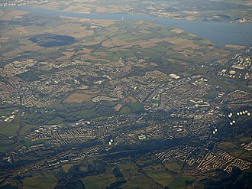
II. Natural Geography (environment and resources)
Transport
The Falkirk Area occupies a central position in Scotland, with direct access from the key north-south and east-west motorway networks; the M9 from the north and east, and the M876 from the west. Falkirk has main rail and canal routes within easy reach from Edinburgh and Glasgow and is central to access to both Glasgow and Edinburgh airports. Falkirk is well situated both for access by rail from England and for access to other parts of Scotland excluding Fife, which has no direct rail link to Falkirk other than morning and evening commuter services from Kirkcaldy to Glasgow. Road access is to Fife provided by the Kincardine Bridge, Clackmannanshire Bridge and the Forth Road Bridge via the M9.
Falkirk has two railway stations; Falkirk High and Falkirk Grahamston.
Falkirk High is on the main Glasgow-Edinburgh line, with connections to either city running on a 15-minute frequency. At peak times 8 trains per hour stop; 4 for Glasgow Queen Street via Croy and 4 for Edinburgh Waverley via Polmont and Linlithgow. Journey times to Edinburgh vary from 24 minutes to 35 minutes depending on stopping stations and time of day; to Glasgow the journey time is between 18 and 28 minutes.
Falkirk Grahamston lies on the Edinburgh to Dunblane Line. To Edinburgh Waverley there are 4 trains per hour, with journey times varying from 25 minutes to 34 minutes; faster trains stop at Edinburgh Park and Haymarket, slower trains additionally stop at Polmont and Linlithgow. To Glasgow Queen Street there are 2 trains per hour via the Cumbernauld Line with journey times from 39 minutes to 43 minutes, plus an evening express service (the 17.33 from Glasgow to Markinch) taking 26 minutes. There is also a daily direct service to/from London (King's Cross) provided by London North Eastern Railway, and the Caledonian Sleeper to London Euston in the southbound direction only also calls here. The main station building was opened in 1985 and serves over 950,000 passenger journeys each year.
Falkirk bus station lies in the town centre and has bus routes providing links to the cities of Stirling, Edinburgh and Glasgow as well as local routes.
Geography
Falkirk is located in an area of undulating topography between the Slamannan Plateau and the upper reaches of the Firth of Forth. The area to the north of Falkirk is part of the floodplain of the River Carron. Two tributaries of the River Carron - the East Burn and the West Burn flow through the town and form part of its natural drainage system. Falkirk sits at between 50 metres (164 ft) and 125 metres (410 ft) above sea level.
The underlying geology of the town of Falkirk is characterised by glacial deposits. Elevations above 100 metres (328 ft) are covered by a mixture of glacial till and boulder clay with low-lying areas covered by sandy soils and loams. As Falkirk is not far from the coast, post-glacial features akin to raised beaches are particularly predominant to the north of the town centre, and this gives rise to differing elevations within the town.
Unsorted glacial till gives rise to such features of glacial deposition as eskers, and drumlins which are predominant over much of the area. Such elements provide natural transport routes and it is this complex underlying geology that the town is built upon.
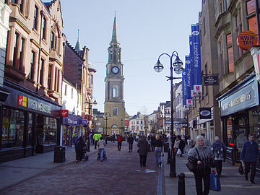
III. Economy
In Scotland, GDP per capita varies from €16,200 in North & East Ayrshire to €50,400 in Edinburgh city.1.1 million (20% of Scots) live in these five deprived [GDP per person is under €20,000] Scottish districts: Clackmannshire & Fife, East & Mid Lothian, West Dumbartonshire, East & North Ayrshire, Caithness Sutherland & Ross.
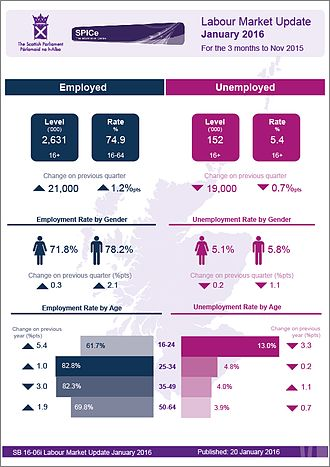
Relative Poverty in Scotland 2013-14
According to Eurostat figures (2013) there are huge regional disparities in the UK with GDP per capita ranging from €15,000 in West Wales to €179,800 in Inner-London West. The average GDP per capita in the South East England region (excludes London) is €34,200 with no local government area showing a GDP per capita of less than €20,000.Equally, there are 21 areas in the rest of the UK where the GDP per person is under €20,000: 4.5 million (8.5% of English) live in these deprived English districts.
The figures below, noting the economic position of Scottish regions in terms of GDP and GDP per capita, come from Eurostat (2013) and are denoted in Euros. It should also be noted that the Scottish figures exclude offshore oil revenue. There are 26 areas in the UK where the GDP per person is under €20,000.
GDP by area | ||
Area | Total | Per capita |
Tayside | €13 bn | €25,950 |
Angus & Dundee | €6.5 bn | €24,500 |
Perth & Kinross & Stirling | €6.5 bn | €27,400 |
Dumfries & Galloway | €3 bn | €20,500 |
Scottish Borders | €2.3 bn | €20,300 |
Clackmann. & Fife | €8.3 bn | €19,900 |
Falkirk | €3.4 bn | €21,800 |
Reference Website:
https://www.payscale.com/research/UK/Location=Norwich-England%3A-Norfolk/Salary
IV. Industrial Characterisitics
Major industries:
Falkirk (/ˈfɔːlkɜːrk/; Scots: The Fawkirk; Scottish Gaelic: An Eaglais Bhreac) is a large town in the Central Lowlands of Scotland, historically within the county of Stirlingshire. It lies in the Forth Valley, 23.3 miles (37.5 km) north-west of Edinburgh and 20.5 miles (33.0 km) north-east of Glasgow.
Falkirk had a resident population of 32,422 at the 2001 UK Census. The population of the town had risen to 34,570 according to a 2008 estimate, making it the 20th most populous settlement in Scotland. Falkirk is the main town and administrative centre of the Falkirk council area, which has an overall population of 156,800 and inholds the nearby towns of Grangemouth, Bo'ness, Denny, Larbert and Stenhousemuir, and the cluster of Braes villages.
The town is at the junction of the Forth and Clyde and Union Canals, a location which proved key to its growth as a centre of heavy industry during the Industrial Revolution. In the eighteenth and nineteenth centuries, Falkirk was at the centre of the iron and steel industry, underpinned by the Carron Company in nearby Carron. The company was responsible for making carronades for the Royal Navy and later manufactured pillar boxes and phone boxes. Within the last fifty years, heavy industry has waned, and the economy relies increasingly on retail and tourism. Despite this, Falkirk remains the home of many international companies like Alexander Dennis; the largest bus production company in the United Kingdom.
Falkirk has a long association with the publishing industry. The company now known as Johnston Press was established in the town in 1846. The company, now based in Edinburgh, produces the Falkirk Herald, the largest selling weekly newspaper in Scotland.
Attractions in and around Falkirk include the Falkirk Wheel, The Helix, The Kelpies, Callendar House and Park and remnants of the Antonine Wall. In a 2011 poll conducted by STV, it was voted as Scotland's most beautiful town, ahead of Perth and Stirling in second and third place respectively.
Major projects and related introductions:
The Helix (Falkirk)
The Helix is a land transformation project to improve the connections between and around 16 communities in Falkirk Council, Scotland, including the eastern end of the Forth and Clyde Canal, and to regenerate the area near where the canal joins the River Carron. The most visible feature of the development is the two unique equine sculptures known as The Kelpies.
The Forth and Clyde Canal was reopened as part of the Millennium Link project in 2001, and included the Falkirk Wheel, a 100-foot (30-metre) revolving boat lift which connects it to the Union Canal. By 2014, the Falkirk Wheel had become one of Scotland's most popular tourist attractions, second only to Edinburgh Castle among destinations that charge for entry. The canals from there to Glasgow and Edinburgh have also become popular, but the final 4 miles (6 kilometres) of the Forth and Clyde Canal from the Wheel to Grangemouth, descending through a flight of 12 locks and two single locks, was little used.The final part of the route to the original outlet at Grangemouth Docks had been obliterated by the construction of a motorway, a road, housing and factories. An alternative route was opened; it connected to the River Carron through a sea lock further upstream, but was not ideal, as the river was crossed by two road bridges and two pipe bridges below the entrance lock. This provided limited headroom when the tide was high, and insufficient water to enter the lock when it was low; an alternative route was therefore sought.
V. Attractions
1. Bonnyview Nursery:
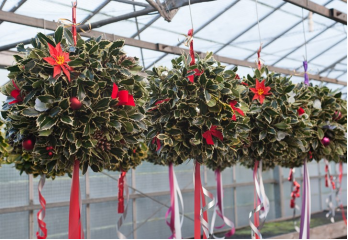
Bonnyview Nursery is open to the public and situated beside the Larbert railway viaduct on the Falkirk/Stirling A9. They have a selection of garden perennials, shrubs and bedding plants alongside fruit and vegetable plants in case you’re interested in growing your own.
Bonnyview Nursery specialises in colour coordinated arrangements of planted hanging baskets and planters during the summer season alongside holly balls, wreaths and Christmas trees during the winter season.
2. Callendar House and Park:
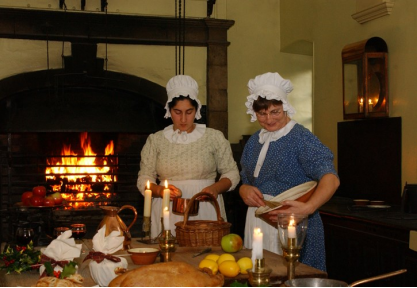
These amenities are seasonal and operate from April - September.The Kiosk is open daily for hot and cold snacks and drinks. Keep checking the Falkirk Community Trust Website for information about the range of events and activities within Callendar House for kids.
As part of the development of Callendar Park, a new Natural Play Trail has been developed. The Natural Play project has focused on creating new, exciting, natural outdoor play within the park centered around a clearly waymarked trail. Providing opportunities for all ages, even adults, to play and exercise in creative and different ways to meet their varying abilities and drives. The result is an inspiring, challenging space for children, their families and carers which helps everyone achieve the recommended 20mins of daily excerise suggested to improve and maintain good health.”
The park is also home to a beautiful undulating par three golf course set in stunning woodland that will test your skills over 9 holes ranging up to 142 yards. There’s a staffed locker room, incorporating a General Purpose room which is available for hire. Clubs and balls are also available for hire.
3. Kinneil Estate Park:
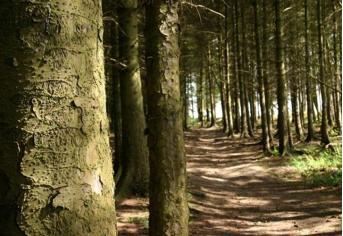
Kinneil Estate is home to a variety of attractions with many activities taking place within the grounds such as walking, cycling and bird-watching.
The park consists of the surrounding acres of woodland and ponds, where you might be lucky enough to see coots, buzzards and swans – plus many other animals.
There are occasional guided walks through the park, in addition to the Step Forth health walks that run three times a week around the estate, check with Kinneil Museum for details of when these guided tours take place. For more details about the free walking group, visit the Step Forth section of the Kinneil House website.
Kinneil Estate is also home to Kinneil House and Kinneil Museum. These two attractions are free to the public and are filled with history. Kinneil Museum is built on Roman remains and is normally open six days a week, check their website for more information and opening times.
Reference Website:
http://www.visitfalkirk.com/things-to-do/parks,-nature-and-garden-centres/#
VI. History
An Eaglais Bhreac is a derivative formed from the Scottish Gaelic cognate of the first recorded name Ecclesbrith from the Brittonic for "speckled church", presumably referring to a church building built of many-coloured stones. The Scottish Gaelic name was calqued into Scots as Fawkirk (literally "variegated church"), then later amended to the modern English name of Falkirk. The Latin name Varia Capella also has the same meaning. Falkirk Old Parish Church stands on the site of the medieval church, which may have been founded as early as the 7th century.
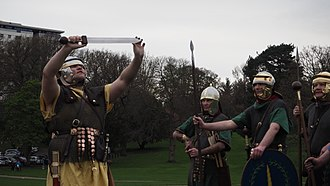
The Antonine Wall, which stretches across the centre of Scotland, passed through the town and remnants of it can be seen at Callendar Park. Similar to Hadrian's Wall but built of turf rather than stone so less of it has survived, it marked the northern frontier of the Roman Empire between the Firth of Forth and Firth of Clyde during the AD 140s. Much of the best evidence of Roman occupation in Scotland has been found in Falkirk, including a large hoard of Roman coins and a cloth of tartan, thought to be the oldest ever recorded. A Roman fort was confirmed to be found by Geoff Bailey in the Pleasance area of Falkirk in 1991. A Roman themed park at Callendar House was awarded lottery funding to help raise awareness of the wall.
In the 18th century the area was the cradle of Scotland's Industrial Revolution, becoming the earliest major centre of the iron-casting industry. James Watt cast some of the beams for his early steam engine designs at the Carron Iron Works in 1765. The area was at the forefront of canal construction when the Forth and Clyde Canal opened in 1790. The Union Canal (1822) provided a link to Edinburgh and early railway development followed in the 1830s and 1840s. The canals brought economic wealth to Falkirk and led to the town's growth. Through time, trunk roads and motorways followed the same canal corridors through the Falkirk area, linking the town with the rest of Scotland. Many companies set up work in Falkirk due to its expansion. A large brickworks was set up at this time, owned by the Howie family. During the 19th century, Falkirk became the first town in Great Britain to have a fully automated system of street lighting, designed and implemented by a local firm, Thomas Laurie & Co Ltd.
VII. Culture
Falkirk hosted a national arts festival which ran in Callendar Park from 2000-2009 called Big In Falkirk. After its inception in 2000, the festival won Scottish Thistle Award for Events & Festivals in 2005. Consisting of a free weekend of events, the festival was one of the largest cultural events in Scotland, attracting over 100,000 people. Hosted in Falkirk’s historical Callendar Park, the venue covers 180-acre (0.73 km2) with Callendar House as the focal point, the entertainment featured a wide variety of outdoor theatre, pyrotechnic displays, arts, comedy and big name music acts, alongside activities for all ages.
Falkirk hosted the Royal National Mòd in 2008. The Gold medals were won by Falkirk resident Lyle Kennedy and Kerrie Finlay from Inverness. Interest in Gaelic has grown in Falkirk since the Mòd and there are now five Gaelic organisations active in the Falkirk area: An Clas Gàidhlig (provides Gaelic lessons to adults), An Comunn Gàidhealach Meur na h-Eaglaise Brice (is the local branch of An Comunn Gàidhealach), Fèis Fhoirt (provides traditional music and Gaelic song tuition for children and adults), Falkirk Gaelic Forum (promotes Gaelic in Falkirk) and Falkirk Junior Gaelic Choir (is a long established and successful youth choir).
Media
Falkirk is served by a weekly newspaper, the Falkirk Herald, which is published by Johnston Press. The company was established by the Johnston family from Falkirk, who have been involved in publishing since 1767. The family acquired the Herald, their first newspaper, in 1846. The publishing company was renamed F Johnston & Co Ltd in 1882, a title it would retain until it was floated on the London Stock Exchange as Johnston Press in 1988. The corporate headquarters of Johnston Press are now in Edinburgh, but the company retains two offices in Falkirk and Grangemouth.
Recreation
The historical Callendar House is an imposing mansion with a 600-year history which is now a museum and also has a cafe and shop. The Park Gallery, a contemporary art gallery is also based in the house.
Landmarks
The Falkirk Wheel, the only rotary canal connector in the world, is located within Falkirk. The attraction was completed in 2002 and it connects the Forth and Clyde Canal to the Union Canal. In Falkirk High Street lies the Falkirk Steeple, the current building was built in 1814 and is protected as a category A listed building. A stylised image of the steeple appears on the crest of Falkirk Football Club. It is widely regarded as the centre point of the town.
Religion
The 2001 census showed the majority of the population claim to belong to one of the Christian denominations with 48% of these being Church of Scotland, 12% being Roman Catholic, and 5% belonging to other Christian denominations. A percentage of people (29) belong to no religion, about 1% above the national figure. The Church of Scotland's Presbytery of Falkirk includes congregations in Bo'ness, Bonnybridge, Cumbernauld, Grangemouth and Larbert, as well as Falkirk.
VIII. Other information
Football
Falkirk F.C. was founded in 1876 and was elected to compete in the Scottish Football League in 1902. The club's highest ranking came in the 1907–08 season and once again in 1909–10 when the club finished runners-up of Division One, the country's top football division, losing out to Celtic F.C. on both occasions. The club has reached the final of the Scottish Cup on five occasions, emerging victorious twice in 1913 and 1957 respectively. The club currently competes in the Scottish Championship and plays their home games at the Falkirk Stadium near Grangemouth.
The town's other men's club, East Stirlingshire F.C., was founded in 1881 originally as Bainsford Britannia and has competed in the Scottish Football League since 1900. The club has predominantly played in the lower leagues of Scottish football, spending only two whole seasons in the top division after being promoted from Division Two in 1931–32 and 1962–63. The club currently competes in the Lowland Football League and from the 2018-19 season will play their home games at the Falkirk Stadium following a groundshare agreement with Falkirk F.C. Firs Park was the home of the club for the majority of the club's existence but was vacated at the end of the 2007/08 season.
Falkirk currently has two women's football teams, Central Girls Football Academy and Falkirk Ladies. Central play in the second tier (SWPL2) and Falkirk play in the third tier (SWFL) of women's football.
Roller Derby
Falkirk is home to Scotland's first Co-ed Roller Derby League. Clubs from the area are the Skelpies men's team, the Central Belters women's team and the Belter Skelpers Co-ed team.
Rugby
Falkirk Rugby Club can trace their roots to 1906 when F.R.F.C. was first formed. It was disbanded at the start of World War 1. In 1972 the club was resurrected when the works team from ICI Grangemouth decided to become "open" and looked for a new home. They initially played at Stirling Road playing fields before building their clubhouse at the present site at Sunnyside in 1981. The club has risen through the ranks of rugby winning six consecutive promotions, five of them as league champions, a Scottish record.
Hockey
Falkirk also has a Hockey team, Falkirk GHG Hockey Club, which was formed from the merger of Graeme High School Former Pupils Hockey Club and Grangemouth Hockey Club in 1999. It now has four men's teams which play in various leagues, with their first team playing in the national league.
Basketball
Falkirk Fury Basketball Club, currently called Clark Eriksson Fury Basketball Club in a sponsorship deal with local firm Clark Eriksson, represents the town in the sport. The team was established in 1992 and originally consisted of players from Falkirk High School and sports development players. Today the team competes in all 6 Scottish National Age Groups. The men's side currently competes in the Scottish Men's National League, the top league in Scottish basketball and is considered the second tier of British basketball below the BBL and in line with the English Basketball League. The club plays home games at the Mariner Centre in Camelon or sometimes at the Grangemouth sports complex.
IX. Contact information
Mayor/Officer: David Aitchison
Tel: 07484926985
Mail: david.aitchison@falkirk.gov.uk
Reference Website:
https://www.falkirk.gov.uk/services/council-democracy/councillors-decision-making/councillors/ward-1/david-aitchison.aspx
